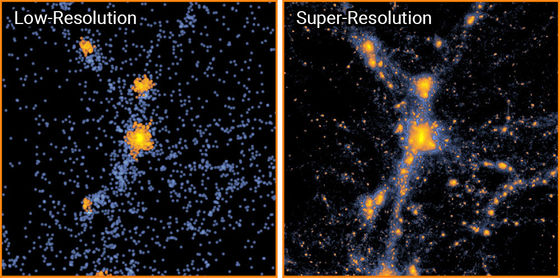Technology that simulates the universe with super high speed and high accuracy with AI has appeared, processing analysis that took 560 hours in only 36 minutes

A technology has been announced that uses artificial intelligence (AI) to analyze astronomical observation data and simulate the structure of the universe in an extremely short time. This is expected to speed up space research, which previously had to take an enormous amount of time.
AI-assisted superresolution cosmological simulations | PNAS
Machine Learning Accelerates Cosmological Simulations --NSF AI Planning Institute for Data-Driven Discovery in Physics --Carnegie Mellon University
https://www.cmu.edu/ai-physics-institute/news/2021-05-05_supersims.html
New application of AI just removed one of the biggest roadblocks in astrophysics --ScienceDaily
https://www.sciencedaily.com/releases/2021/05/210504191602.htm
Simulating the structure of the universe from the observation results collected by astronomical telescopes is an indispensable task for deepening the understanding of the universe and elucidating the true nature of dark matter, which is one of the greatest mysteries of the universe. .. However, this requires enormous computational costs and has traditionally sacrificed simulation range and / or accuracy.
Therefore, a research team led by Tiziana Di Matteo, a professor of physics at Carnegie Mellon University in the United States, trained machine learning algorithms based on the Generative Adversarial Network (GAN) with high-resolution image data. We have developed an AI that accurately generates high-resolution image data from resolution images.
The AI developed in this way can generate an ultra-high resolution image (right) containing 512 times as many particles as the original from a low resolution image (left).

Also, the time required for analysis has been significantly reduced. For example, in the case of a model with 134 million particles in the area of about 500 million light years, it took 560 hours to simulate in the past, but AI completed it in only 36 minutes. Furthermore, even if the number of particles is increased 1000 times to 134 billion, AI can be completed in just 16 hours, although it takes several months even if a dedicated supercomputer is used with the conventional simulation method. The team says.
Di Matteo commented on this result: 'Reducing the time it takes to simulate the universe could bring significant advances in physics and astronomy. Simulating the universe could bring about the past of the universe, such as the formation of galaxies and black holes. Because you can trace the history from to the future. '
Yin Li of the American Flatiron Institute, the lead author of the paper, said, 'I had been stuck for two years, but suddenly it started to work, and the beautiful results I expected. No one could tell clearly which was real and which was fake by comparing the actual image with the one generated by AI. '
The AI developed this time was developed using a method that predicts the effect of gravity on dark matter, so although it is good at simulating the large-scale structure of the universe, it can be seen from the entire universe such as the birth of stars, supernovae, and black holes. If you look at it, relatively small-scale phenomena will be ignored. The research team plans to improve the accuracy of AI by executing conventional methods and simulations using AI in parallel.
Related Posts:







